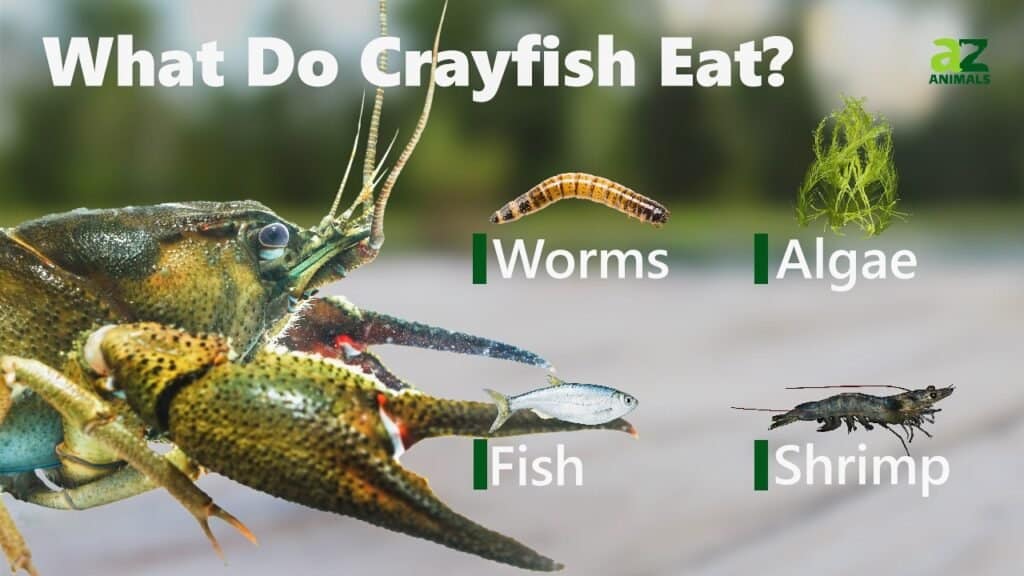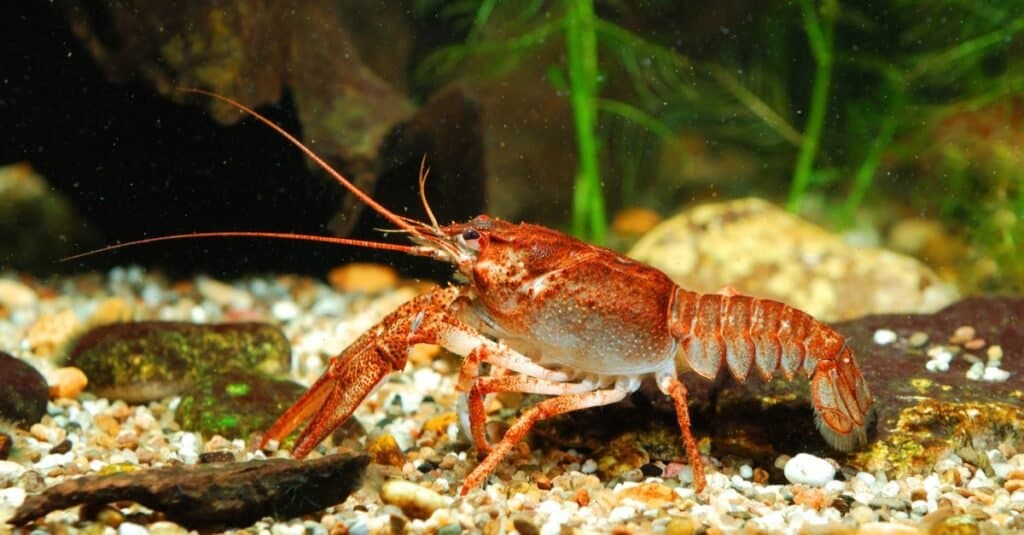To many people around the world, crayfish (also called crawfish or crawdad) is food. It is Louisiana‘s official state crustacean. But what does the food eat?
Crayfish are freshwater crustaceans that look like small lobsters and even taste like lobster but are small like shrimp, with fattier tail meat than shrimp, and with fat stored in the head. And unlike the treatment of lobsters as a delicacy, crayfish are often used in home cooking.
Let’s explore together what these so-called freshwater lobsters, rock lobsters, or mountain lobsters eat.
What Crayfish Eat

The crawdad or crawfish diet is omnivorous, that is, they eat both plant and animal matter. Their habitat in the wild is flowing streams such as in a river or brook, but sometimes also in a pond, swamp, or ditch. Flowing rather than stagnant water allows them to reach their food easily. What they eat is anything that can float by them or sink to the bottom. Crayfish eat decaying vegetation and aquatic creatures such as rotten leaves, dead fish, algae, plankton, and twigs.
But they can also be hunters and eat small worms, snails, eggs, larvae, insects, shrimps, fish, tadpoles, baby turtles, frogs, and even their own baby crayfish. Baby crayfish eat mostly algae. The crayfish diet in the wild is similar to that in a pond, but people who farm crayfish in ponds also feed them prepared vegetables and commercial food.
A Complete List of Foods Crayfish Eat
In the wild:
- Decaying vegetation, such as leaves or twins
- Dead fish
- Plankton and algae
- small worms, snails, eggs, larvae, insects, shrimps, fish, tadpoles, baby turtles, frogs
- Baby crayfish
In a pond:
- Decaying vegetation
- Dead fish
- Small aquatic creatures, invertebrates, eggs, larvae, and babies
- Baby crayfish
- Commercial pellets and algae
- Prepared vegetables
Baby crayfish:
- Pellets
- Algae
- Very soft-boiled veggies
Can Crayfish Eat Frozen Fish?
Water snails play a role in maintaining tank cleanliness, but crayfish will also consume them. Additionally, crayfish are receptive to various food sources, including frozen fish, shrimp, crab, waterlogged oak leaves, small minnows, and morsels of earthworm.
Occasionally, crayfish can enjoy frozen aquarium foods like daphnia, bloodworms, and brine shrimp.
However, it’s crucial never to feed them live or uncooked shrimp, as shrimp can carry diseases that pose a fatal risk to crayfish.

A crayfish in an aquarium. Crayfish are decomposers as well as detritivores.
©Alex Stemmers/Shutterstock.com
The Crayfish Digestive System
The crawfish or crawdad is a decomposer as well as a detritivore, but it’s also a filter-feeder that takes in what’s suspended in water while already whole or in pieces. It must therefore have a unique digestive system that allows it to break down what it eats. The first organ is a two-part stomach. The cardiac stomach stores food and mechanically breaks it down with teeth, while the pyloric stomach chemically breaks it down, similar to the stomachs of vertebrates such as humans.
There’s also a digestive gland, similar to a liver, and the intestine, which absorbs nutrients and excretes waste from the anus.
Foods That Are Bad or Toxic for Crayfish
Crayfish and other shellfish absorb toxins from the water. Some phytoplankton species also have toxins that can accumulate in shellfish and other creatures that eat them, but they accumulate at higher levels in larger creatures at the top of the food chain.
Crayfish, crawfish, or crawdads are staple shellfish around the world and are the focus of certain spicy country cuisines, where they taste similar to and cook the same as lobster. These freshwater crustaceans lack a seawater flavor, unlike their saltwater counterparts, but they are likewise omnivorous. They are so savory and delicious because they eat a protein-rich diet.
What is the lifespan of a crayfish?
A crayfish reaches adult size in 3-4 months & its life span is 3-8 years long. They grow old quickly. The crayfish will either mate and start the process over again, or it will die.
The photo featured at the top of this post is © Alex Stemmers/Shutterstock.com
Thank you for reading! Have some feedback for us? Contact the AZ Animals editorial team.






